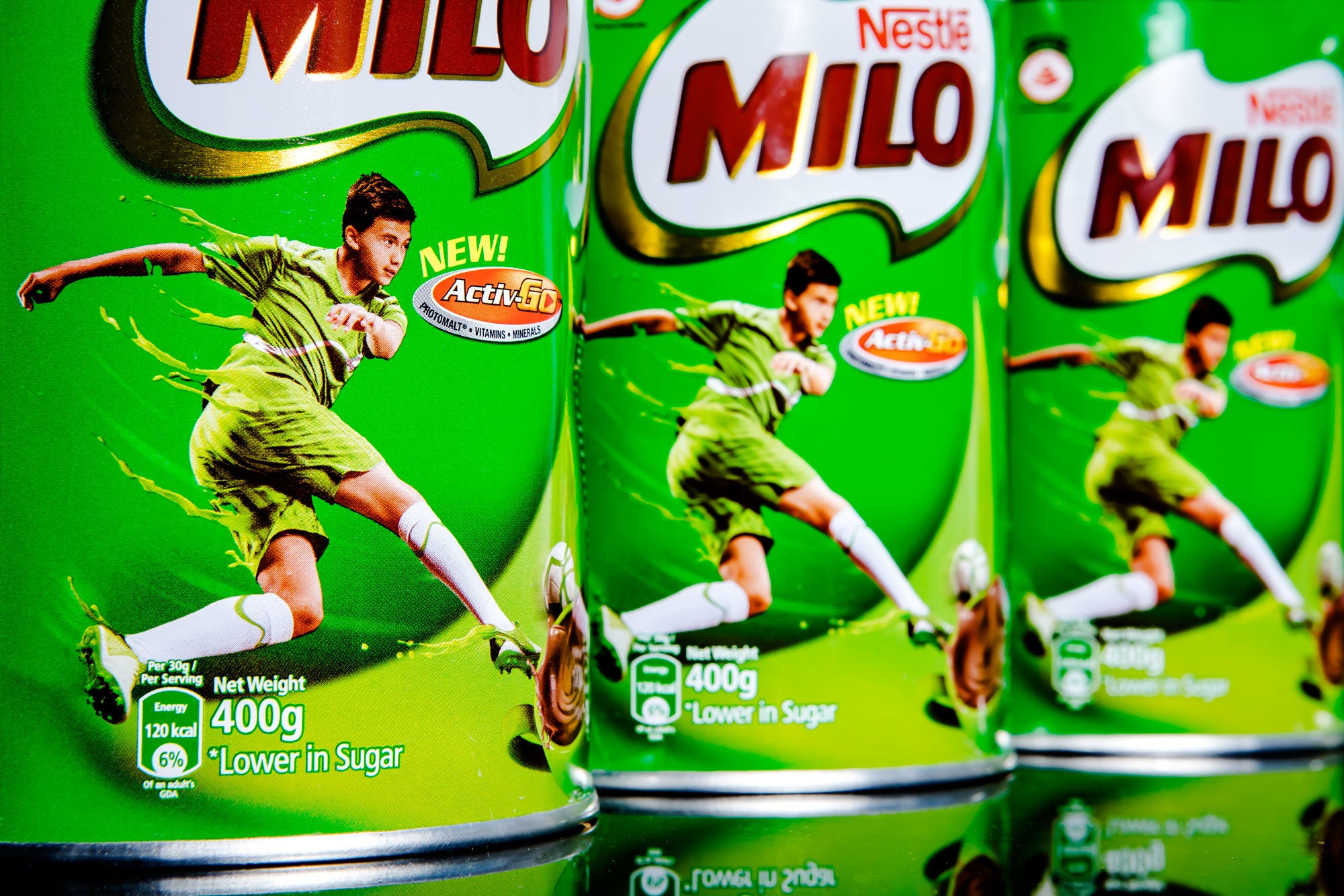
For Malaysians, it was a chocolate malt milk drink, not Gatorade, that fueled a generation of athletes.
A mug of Milo is as Malaysian as a bowl of nasi lemak. In a country home to the highest number of Milo drinkers per capita (though the drink has a cult following in Colombia, too), the malty, chocolaty drink is sold everywhere, from McDonald’s to mamaks to roadside vans—brewed hot or cold, served plainly mixed with water or splashed milk, sweetened with condensed milk or sugar, slowly sipped on or ordered to go.
But the story of Milo doesn’t start in Malaysia. In 1934, the powdered drink mix made of milk, malt, and chocolate was invented in Australia by Nestlé scientist Thomas Mayne. It wasn’t until 1950 that Milo swam to Malaysian shores under the guise of a nutrition supplement. In fact, across the world, the mix-in chocolate powder was a sneaky way to get children to drink more milk. Its original tagline, “Nestlé’s Fortified Tonic Food,” was emblazoned across its verdant tin cans. Plus, a series of commercials and banners touted its high content of “essential minerals” and “energizing vitamins.”
A sip of Milo is evocative of a melted Malteser or Whopper—a comforting, calorific concoction of cocoa, made edgy thanks to the toasty, nutty depth of the malt. But it wasn’t until Milo rebranded in the ’80s that it came into its own as the de facto sports drink of the nation.
Chocolate and sports make for an unlikely combination, especially considering today’s electrolyte-spiked Gatorades and Pocari Sweats. But back in ’80s Malaysia, a time when the national sports scene was booming (the five Sidek brothers were dominating the badminton circuit, and the football team qualified for the Olympics for the first time in 1972, and again in 1980), Milo capitalized on the burgeoning scene with its Kelly-green vans and kitschy ads full of baritone voiceovers.
Milo played up its namesake (a legendary Olympic wrestler from ancient Greece) and debuted a new, not-so-subtle slogan, “Drinking Milo makes you healthy and strong!” For two decades, attending any sports-related event—from regional football matches at stadiums to tiny, intramural badminton matches—meant seeing a branded van parked at the edge of the venue, giving out free, ready-to-drink Milo juice boxes. Nestlé went on to sponsor badminton clinics, football matches, and even movie screenings free of charge and complete with free-flowing Milo.
Before Red Bull could give you wings, Milo “brought out the champion in you”—yet another iconic catchphrase of the era. With endorsements by legendary squash player Nicol David and 46-time badminton champion Lee Chong Wei, who wouldn’t want to believe that? The mighty powdered chocolate can even take credit (in collaboration with the Olympic Council of Malaysia) for the national sports catchphrase “Malaysia Boleh!” (meaning “Malaysia Can Do It!”), still hollered at today’s Olympic events and football World Cup qualifiers.
The nationwide love of Milo made it more than just a drink; it became a flavor that resonates with Malaysians across the world. Naturally, it was spun off into ice creams, energy bars, and oozy, Kinder Bueno–like bonbons for a familiar taste of childhood. For me, it’s a Milo Dinosaur, made with spoonfuls of Milo simply stirred into chilled milk and ice, topped off with a Jurassic heap of even more chocolaty crumb.
In New York, café owners Kyo Pang and Moonlynn Tsai of Kopitiam incorporate it into French toast, a regular fixture on their menu that Tsai describes as “a fun infusion of two cultures into a dish,” inspired by her Milo-laden childhood and her penchant for using the powder as an ice cream garnish, “making for a delicious substitute for sprinkles.” Helen Goh, product developer at London’s Ottolenghi and coauthor of Sweet, still regularly stocks her pantry with tins of Milo for her highly personalized routine brew, which involves stirring the powder into cold milk “so most of it doesn’t melt but stays crunchy and afloat.”
Even as the children of Milo’s heyday have transitioned into Malaysia’s working class, even as there’s a growing trend away from processed foods, and even as Milo is edged out of the sporting scene by bullish competitors, there’s no other drink that encapsulates the Malaysian spirit—within sports and without—quite like a steaming mug of Milo.